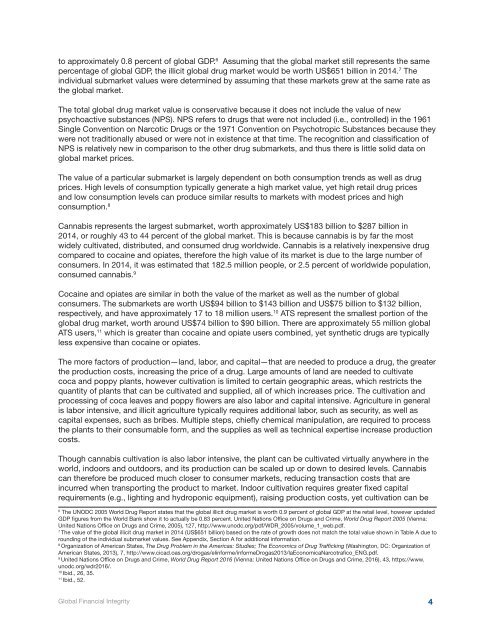Transnational Crime and the Developing World
Transnational_Crime-final
Transnational_Crime-final
Create successful ePaper yourself
Turn your PDF publications into a flip-book with our unique Google optimized e-Paper software.
to approximately 0.8 percent of global GDP. 6 Assuming that <strong>the</strong> global market still represents <strong>the</strong> same<br />
percentage of global GDP, <strong>the</strong> illicit global drug market would be worth US$651 billion in 2014. 7 The<br />
individual submarket values were determined by assuming that <strong>the</strong>se markets grew at <strong>the</strong> same rate as<br />
<strong>the</strong> global market.<br />
The total global drug market value is conservative because it does not include <strong>the</strong> value of new<br />
psychoactive substances (NPS). NPS refers to drugs that were not included (i.e., controlled) in <strong>the</strong> 1961<br />
Single Convention on Narcotic Drugs or <strong>the</strong> 1971 Convention on Psychotropic Substances because <strong>the</strong>y<br />
were not traditionally abused or were not in existence at that time. The recognition <strong>and</strong> classification of<br />
NPS is relatively new in comparison to <strong>the</strong> o<strong>the</strong>r drug submarkets, <strong>and</strong> thus <strong>the</strong>re is little solid data on<br />
global market prices.<br />
The value of a particular submarket is largely dependent on both consumption trends as well as drug<br />
prices. High levels of consumption typically generate a high market value, yet high retail drug prices<br />
<strong>and</strong> low consumption levels can produce similar results to markets with modest prices <strong>and</strong> high<br />
consumption. 8<br />
Cannabis represents <strong>the</strong> largest submarket, worth approximately US$183 billion to $287 billion in<br />
2014, or roughly 43 to 44 percent of <strong>the</strong> global market. This is because cannabis is by far <strong>the</strong> most<br />
widely cultivated, distributed, <strong>and</strong> consumed drug worldwide. Cannabis is a relatively inexpensive drug<br />
compared to cocaine <strong>and</strong> opiates, <strong>the</strong>refore <strong>the</strong> high value of its market is due to <strong>the</strong> large number of<br />
consumers. In 2014, it was estimated that 182.5 million people, or 2.5 percent of worldwide population,<br />
consumed cannabis. 9<br />
Cocaine <strong>and</strong> opiates are similar in both <strong>the</strong> value of <strong>the</strong> market as well as <strong>the</strong> number of global<br />
consumers. The submarkets are worth US$94 billion to $143 billion <strong>and</strong> US$75 billion to $132 billion,<br />
respectively, <strong>and</strong> have approximately 17 to 18 million users. 10 ATS represent <strong>the</strong> smallest portion of <strong>the</strong><br />
global drug market, worth around US$74 billion to $90 billion. There are approximately 55 million global<br />
ATS users, 11 which is greater than cocaine <strong>and</strong> opiate users combined, yet syn<strong>the</strong>tic drugs are typically<br />
less expensive than cocaine or opiates.<br />
The more factors of production—l<strong>and</strong>, labor, <strong>and</strong> capital—that are needed to produce a drug, <strong>the</strong> greater<br />
<strong>the</strong> production costs, increasing <strong>the</strong> price of a drug. Large amounts of l<strong>and</strong> are needed to cultivate<br />
coca <strong>and</strong> poppy plants, however cultivation is limited to certain geographic areas, which restricts <strong>the</strong><br />
quantity of plants that can be cultivated <strong>and</strong> supplied, all of which increases price. The cultivation <strong>and</strong><br />
processing of coca leaves <strong>and</strong> poppy flowers are also labor <strong>and</strong> capital intensive. Agriculture in general<br />
is labor intensive, <strong>and</strong> illicit agriculture typically requires additional labor, such as security, as well as<br />
capital expenses, such as bribes. Multiple steps, chiefly chemical manipulation, are required to process<br />
<strong>the</strong> plants to <strong>the</strong>ir consumable form, <strong>and</strong> <strong>the</strong> supplies as well as technical expertise increase production<br />
costs.<br />
Though cannabis cultivation is also labor intensive, <strong>the</strong> plant can be cultivated virtually anywhere in <strong>the</strong><br />
world, indoors <strong>and</strong> outdoors, <strong>and</strong> its production can be scaled up or down to desired levels. Cannabis<br />
can <strong>the</strong>refore be produced much closer to consumer markets, reducing transaction costs that are<br />
incurred when transporting <strong>the</strong> product to market. Indoor cultivation requires greater fixed capital<br />
requirements (e.g., lighting <strong>and</strong> hydroponic equipment), raising production costs, yet cultivation can be<br />
6<br />
The UNODC 2005 <strong>World</strong> Drug Report states that <strong>the</strong> global illicit drug market is worth 0.9 percent of global GDP at <strong>the</strong> retail level, however updated<br />
GDP figures from <strong>the</strong> <strong>World</strong> Bank show it to actually be 0.83 percent. United Nations Office on Drugs <strong>and</strong> <strong>Crime</strong>, <strong>World</strong> Drug Report 2005 (Vienna:<br />
United Nations Office on Drugs <strong>and</strong> <strong>Crime</strong>, 2005), 127, http://www.unodc.org/pdf/WDR_2005/volume_1_web.pdf.<br />
7<br />
The value of <strong>the</strong> global illicit drug market in 2014 (US$651 billion) based on <strong>the</strong> rate of growth does not match <strong>the</strong> total value shown in Table A due to<br />
rounding of <strong>the</strong> individual submarket values. See Appendix, Section A for additional information.<br />
8<br />
Organization of American States, The Drug Problem in <strong>the</strong> Americas: Studies; The Economics of Drug Trafficking (Washington, DC: Organization of<br />
American States, 2013), 7, http://www.cicad.oas.org/drogas/elinforme/informeDrogas2013/laEconomicaNarcotrafico_ENG.pdf.<br />
9<br />
United Nations Office on Drugs <strong>and</strong> <strong>Crime</strong>, <strong>World</strong> Drug Report 2016 (Vienna: United Nations Office on Drugs <strong>and</strong> <strong>Crime</strong>, 2016), 43, https://www.<br />
unodc.org/wdr2016/.<br />
10<br />
Ibid., 26, 35.<br />
11<br />
Ibid., 52.<br />
Global Financial Integrity<br />
4


